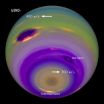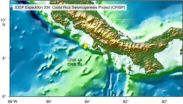(Press-News.org)
VIDEO:
By tracking atmospheric features on Neptune, a UA planetary scientist has accurately determined the planet's rotation, a feat that had not been previously achieved for any of the gas planets...
Click here for more information.
A day on Neptune lasts precisely 15 hours, 57 minutes and 59 seconds, according to the first accurate measurement of its rotational period made by University of Arizona planetary scientist Erich Karkoschka.
His result is one of the largest improvements in determining the rotational period of a gas planet in almost 350 years since Italian astronomer Giovanni Cassini made the first observations of Jupiter's Red Spot.
"The rotational period of a planet is one of its fundamental properties," said Karkoschka, a senior staff scientist at the UA's Lunar and Planetary Laboratory. "Neptune has two features observable with the Hubble Space Telescope that seem to track the interior rotation of the planet. Nothing similar has been seen before on any of the four giant planets."
The discovery is published in Icarus, the official scientific publication of the Division for Planetary Sciences of the American Astronomical Society.
Unlike the rocky planets – Mercury, Venus, Earth and Mars – which behave like solid balls spinning in a rather straightforward manner, the giant gas planets – Jupiter, Saturn, Uranus and Neptune – rotate more like giant blobs of liquid. Since they are believed to consist of mainly ice and gas around a relatively small solid core, their rotation involves a lot of sloshing, swirling and roiling, which has made it difficult for astronomers to get an accurate grip on exactly how fast they spin around.
"If you looked at Earth from space, you'd see mountains and other features on the ground rotating with great regularity, but if you looked at the clouds, they wouldn't because the winds change all the time," Karkoschka explained. "If you look at the giant planets, you don't see a surface, just a thick cloudy atmosphere."
"On Neptune, all you see is moving clouds and features in the planet's atmosphere. Some move faster, some move slower, some accelerate, but you really don't know what the rotational period is, if there even is some solid inner core that is rotating."
In the 1950s, when astronomers built the first radio telescopes, they discovered that Jupiter sends out pulsating radio beams, like a lighthouse in space. Those signals originate from a magnetic field generated by the rotation of the planet's inner core.
No clues about the rotation of the other gas giants, however, were available because any radio signals they may emit are being swept out into space by the solar wind and never reach Earth.
"The only way to measure radio waves is to send spacecraft to those planets," Karkoschka said. "When Voyager 1 and 2 flew past Saturn, they found radio signals and clocked them at exactly 10.66 hours, and they found radio signals for Uranus and Neptune as well. So based on those radio signals, we thought we knew the rotation periods of those planets."
But when the Cassini probe arrived at Saturn 15 years later, its sensors detected its radio period had changed by about 1 percent. Karkoschka explained that because of its large mass, it was impossible for Saturn to incur that much change in its rotation over such a short time.
"Because the gas planets are so big, they have enough angular momentum to keep them spinning at pretty much the same rate for billions of years," he said. "So something strange was going on."
Even more puzzling was Cassini's later discovery that Saturn's northern and southern hemispheres appear to be rotating at different speeds.
"That's when we realized the magnetic field is not like clockwork but slipping," Karkoschka said. "The interior is rotating and drags the magnetic field along, but because of the solar wind or other, unknown influences, the magnetic field cannot keep up with respect to the planet's core and lags behind."
Instead of spacecraft powered by billions of dollars, Karkoschka took advantage of what one might call the scraps of space science: publicly available images of Neptune from the Hubble Space Telescope archive. With unwavering determination and unmatched patience, he then pored over hundreds of images, recording every detail and tracking distinctive features over long periods of time.
Other scientists before him had observed Neptune and analyzed images, but nobody had sleuthed through 500 of them.
"When I looked at the images, I found Neptune's rotation to be faster than what Voyager observed," Karkoschka said. "I think the accuracy of my data is about 1,000 times better than what we had based on the Voyager measurements – a huge improvement in determining the exact rotational period of Neptune, which hasn't happened for any of the giant planets for the last three centuries."
Two features in Neptune's atmosphere, Karkoschka discovered, stand out in that they rotate about five times more steadily than even Saturn's hexagon, the most regularly rotating feature known on any of the gas giants.
Named the South Polar Feature and the South Polar Wave, the features are likely vortices swirling in the atmosphere, similar to Jupiter's famous Red Spot, which can last for a long time due to negligible friction. Karkoschka was able to track them over the course of more than 20 years.
An observer watching the massive planet turn from a fixed spot in space would see both features appear exactly every 15.9663 hours, with less than a few seconds of variation.
"The regularity suggests those features are connected to Neptune's interior in some way," Karkoschka said. "How they are connected is up to speculation."
One possible scenario involves convection driven by warmer and cooler areas within the planet's thick atmosphere, analogous to hot spots within the Earth's mantle, giant circular flows of molten material that stay in the same location over millions of years.
"I thought the extraordinary regularity of Neptune's rotation indicated by the two features was something really special," Karkoschka said.
"So I dug up the images of Neptune that Voyager took in 1989, which have better resolution than the Hubble images, to see whether I could find anything else in the vicinity of those two features. I discovered six more features that rotate with the same speed, but they were too faint to be visible with the Hubble Space Telescope, and visible to Voyager only for a few months, so we wouldn't know if the rotational period was accurate to the six digits. But they were really connected. So now we have eight features that are locked together on one planet, and that is really exciting."
In addition to getting a better grip on Neptune's rotational period, the study could lead to a better understanding of the giant gas planets in general.
"We know Neptune's total mass but we don't know how it is distributed," Karkoschka explained. "If the planet rotates faster than we thought, it means the mass has to be closer to the center than we thought. These results might change the models of the planets' interior and could have many other implications."
INFORMATION:
Clocking Neptune's spin
By tracking atmospheric features on Neptune, a UA planetary scientist has accurately determined the planet's rotation, a feat that had not been previously achieved for any of the gas planets in our solar system except Jupiter
2011-06-30
ELSE PRESS RELEASES FROM THIS DATE:
Scientists develop method to determine order of mutations that lead to cancer
2011-06-30
PORTLAND, Ore. -- Zeroing in on the early cell mutations that enable a cancer to grow is one of the best ways to find a personalized therapy to stop it. Scientists were able to use a statistical approach for the first time to map out the order in which these abnormalities form to analyze the pattern of DNA changes in advanced skin and ovarian tumors.
The study's findings, which are published in the July edition of Cancer Discovery, are the result of a collaboration of scientists at the Oregon Health & Science University Knight Cancer Institute; the Lawrence Berkeley National ...
Perimeter Hotel Invites Guests to Celebrate the Fourth of July in Atlanta With a Special Offer
2011-06-30
Sheraton Atlanta Perimeter hotel North, located near Perimeter Mall and Dunwoody, GA, recently announced a new special savings deal for stays between July 1 - 4, 2011.
Guests who book the 4th of July package, which requires 2 days advance booking, will receive:
- Rates from $124 per night
- Round trip tickets for MARTA with shuttles to and from the MARTA station
- Breakfast for two
- 25% off Food and Beverage
"Atlanta is a great city to celebrate Independence Day in," explains Ajay Sethi, the Perimeter hotel's General Manager. "Area festivities ...
Salt-loving microbe provides new enzymes for the production of next-gen biofuels
2011-06-30
In order to realize the full potential of advanced biofuels that are derived from non-food sources of lignocellulosic biomass—e.g., agricultural, forestry, and municipal waste, and crops such as poplar, switchgrass and miscanthus—new technologies that can efficiently and cost-effectively break down this biomass into simple sugars are required. Existing biomass pretreatment technologies are typically derived from the pulp and paper industry and rely on dilute acids and bases to break down the biomass. The treated biomass product is then exposed to biological catalysts, ...
National Trust Reveals GBP3.5 Million Investment Results at Hidcote Manor
2011-06-30
National Trust has announced that a newly restored semi-tropical plant house, a bathing pool and a summerhouse mural are just some of the results of 10 years of hard work and GBP3.5 million investment at Hidcote Manor garden in Gloucestershire.
The National Trust has now officially completed a major phase of reinstating many of the key historic structures in this world-famous garden thanks to the support of an anonymous donor, who matched every pound raised by the Trust up to GBP1.6 million.
Created by American-born horticulturalist Major Lawrence Johnston, Hidcote ...
Clues to why 'they' all look alike
2011-06-30
Northwestern University researchers have provided new biological evidence suggesting that the brain works differently when memorizing the face of a person from one's own race than when memorizing a face from another race.
Their study -- which used EEG recordings to measure brain activity -- sheds light on a well-documented phenomenon known as the "other-race effect." One of the most replicated psychology findings, the other-race effect finds that people are less likely to remember a face from a racial group different from their own.
"Scientists have put forward numerous ...
Fire brings communities together -- 'You're from the government, we trust you'
2011-06-30
CORVALLIS, Ore. – As homes and cities expand closer to forests and wildlands across the American West, increasing wildfire threats have created an unlikely new phenomena – confidence in government.
Recent studies show that people in neighborhoods adjacent to public forest lands can and do trust natural resource managers to a surprising degree, in part because the risks they face are so severe.
Thousands of acres burn every year, threatening homes, lives and property, and in many groups and areas, the phrase "I'm from the government – trust me" is no longer being used ...
Jumeirah Brand Ambassador Wins His First US Open Title
2011-06-30
Jumeirah Group, the Dubai-based luxury hotel group and member of Dubai Holding, has celebrated the victory of its global brands ambassador, golfer Rory Mcllory, in the US Open at the Congressional Country Club, Bethesda, Maryland, USA.
Rory McIlroy, 22, led the tournament from start to finish, a feat which had not been achieved since Tiger Woods in 2000. McIlroy finished with a score of 268 which is the lowest score in US Open history and a massive 16 under par.
Executive chairman of Jumeirah Group, Gerald Lawless said: "Rory is truly an inspiration. Since his ...
Scientists study earthquake triggers in Pacific Ocean
2011-06-30
Puntarenas, Costa Rica – New samples of rock and sediment from the depths of the eastern Pacific Ocean may help explain the cause of large, destructive earthquakes similar to the Tohoku Earthquake that struck Japan in mid-March.
Nearly 1500 meters (almost one mile) of core collected from the ocean floor near the coast of Costa Rica reveal detailed records of approximately 2 million years of tectonic activity along a seismic plate boundary.
The samples were retrieved with the scientific drilling vessel JOIDES Resolution during the recent month-long Integrated Ocean ...
Debenhams Launches Lightest Ever Bra
2011-06-30
Debenhams has launched its lightest ever t-shirt bra, weighing in at just 48g, as the answer to the perfect everyday bra.
Debenhams head of lingerie buying and design, Sharon Webb commented: "Many women find that the search for a bra that fits, flatters, is comfortable and functional, is as hard as finding the right man.
"Our research showed that many traditional t-shirt bras were quite heavy due to their dense foam structure, which is required to give an invisible fit."
Over 90% of women in wearer trials agreed that the bra felt like a second skin.
Back ...
Heavy metal meets hard rock: Battling through the ocean crust's hardest rocks
2011-06-30
Panama City, Panama – Integrated Ocean Drilling Program (IODP) Expedition 335 Superfast Spreading Rate Crust 4 recently completed operations in Ocean Drilling Program (ODP) Hole 1256D, a deep scientific borehole that extends more than 1500 meters below the seafloor into the Pacific Ocean's igneous crust – rocks that formed through the cooling and crystallization of magma, and form the basement of the ocean floor.
An international team of scientists led by co-chief scientists Damon Teagle (National Oceanographic Center Southampton, University of Southampton in the UK) ...
LAST 30 PRESS RELEASES:
Tracing the quick synthesis of an industrially important catalyst
New software sheds light on cancer’s hidden genetic networks
UT Health San Antonio awarded $3 million in CPRIT grants to bolster cancer research and prevention efforts in South Texas
Third symposium spotlights global challenge of new contaminants in China’s fight against pollution
From straw to soil harmony: International team reveals how biochar supercharges carbon-smart farming
Myeloma: How AI is redrawing the map of cancer care
Manhattan E. Charurat, Ph.D., MHS invested as the Homer and Martha Gudelsky Distinguished Professor in Medicine at the University of Maryland School of Medicine
Insilico Medicine’s Pharma.AI Q4 Winter Launch Recap: Revolutionizing drug discovery with cutting-edge AI innovations, accelerating the path to pharmaceutical superintelligence
Nanoplastics have diet-dependent impacts on digestive system health
Brain neuron death occurs throughout life and increases with age, a natural human protein drug may halt neuron death in Alzheimer’s disease
SPIE and CLP announce the recipients of the 2025 Advanced Photonics Young Innovator Award
Lessons from the Caldor Fire’s Christmas Valley ‘Miracle’
Ant societies rose by trading individual protection for collective power
Research reveals how ancient viral DNA shapes early embryonic development
A molecular gatekeeper that controls protein synthesis
New ‘cloaking device’ concept to shield sensitive tech from magnetic fields
Researchers show impact of mountain building and climate change on alpine biodiversity
Study models the transition from Neanderthals to modern humans in Europe
University of Phoenix College of Doctoral Studies releases white paper on AI-driven skilling to reduce burnout and restore worker autonomy
AIs fail at the game of visual “telephone”
The levers for a sustainable food system
Potential changes in US homelessness by ending federal support for housing first programs
Vulnerability of large language models to prompt injection when providing medical advice
Researchers develop new system for high-energy-density, long-life, multi-electron transfer bromine-based flow batteries
Ending federal support for housing first programs could increase U.S. homelessness by 5% in one year, new JAMA study finds
New research uncovers molecular ‘safety switch’ shielding cancers from immune attack
Bacteria resisting viral infection can still sink carbon to ocean floor
Younger biological age may increase depression risk in older women during COVID-19
Bharat Innovates 2026 National Basecamp Showcases India’s Most Promising Deep-Tech Ventures
Here’s what determines whether your income level rises or falls
[Press-News.org] Clocking Neptune's spinBy tracking atmospheric features on Neptune, a UA planetary scientist has accurately determined the planet's rotation, a feat that had not been previously achieved for any of the gas planets in our solar system except Jupiter



